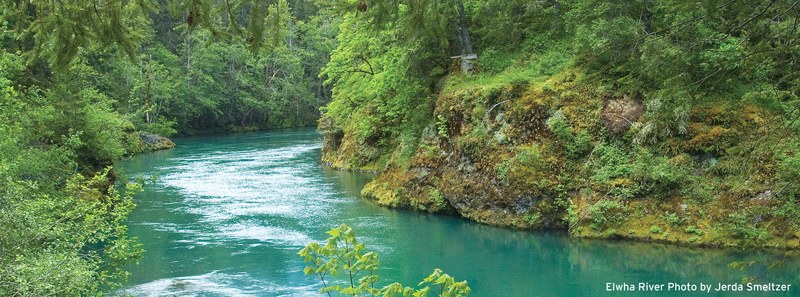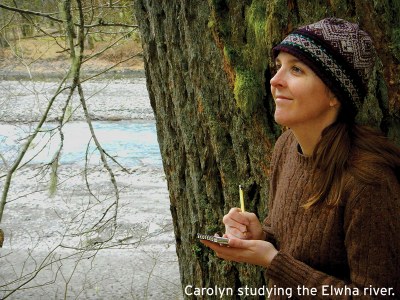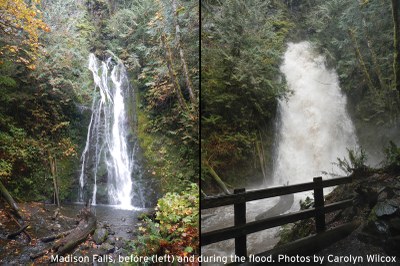
As I look out over a plain of rushing water, a pleasant earthy smell permeates the air, hinting surprisingly of sulfur.
Loud muffled sounds, rather like something large and solid running into something else large and solid, occasionally boom out from different directions.This is what I experienced as I witnessed the flood of the Elwha River on March 6th, 2014.
After consulting with my friends, I come to recognize these booms as large boulders being moved around underwater. Churning, rushing, powerful riffles register at a decibel similar to the Pacific Ocean, but we are far from the coast. I gaze into the water swirling and pooling around me with the color of deep slate gray — it's mesmerizing to behold. I am witnessing the most significant flood event to have occurred on the Elwha River since dam removal started in the fall of 2011 — a fact confirmed by Andy Ritchie, Elwha River Restoration Project Hydrologist. Andy watches with me, and is as elated as my friends and I are to be witnessing peak flooding conditions. Who wouldn’t be excited to see potentially the largest natural movement of colossal amounts of nearly century-old sediment from the former Mills reservoir? This is what Andy and many others had been forecasting during the planning stages of Elwha River restoration — that the mighty Elwha River could restore itself. Today, it is finally happening!
Why does the Elwha River need to be restored?
Well, it started almost 100 years ago with the creation of two hydroelectric dams — the Elwha Dam (lower dam) and the Glines Canyon Dam (upper dam) that created the Aldwell and Mills reservoirs respectively. Modern hydrologists like Ritchie have a much better understanding of the hidden ecological costs of dam construction than turn-of-the-century developer Thomas Aldwell did. When ill-equipped crews under Aldwell's direction began building the Elwha Dam around 1910, a lack of salmon passage was considered to be a bad thing (not to mention illegal since Washington became a territory). But Aldwell built his dam without fish passage, leaving the state to scramble to build a fish hatchery. Not surprisingly, hatcheries on the Elwha failed, and could not replace more than seventy miles of spawning habitat upstream of the lower Elwha Dam. The number of wild Pacific salmon returning to the Elwha River dropped almost immediately with dam construction as fish were only allowed a mere five miles of river before hitting the Elwha Dam. Less well understood at the time of dam construction were the additional ecological effects of dam building such as blocking sediment and woody debris movement downstream.
Erosion of the Olympic Mountains creates sediment and according to Linda Mapes in her 2013 book, Elwha: A River Reborn, the amount of sediment involved in Elwha River restoration differs from other dammed rivers. The Elwha River watershed, which encompasses 321 square miles and includes eight major tributaries, produces a lot of sediment. Over the 100-year lifespan of the Elwha River dams, the Aldwell and Mills reservoirs trapped an estimated 24 million cubic yards of sediment. This explains why the removal of the Elwha River dams is considered to be the largest river restoration project in the world, not only because of the massive amounts of concrete but also because of startling amounts of sediment piled upstream at the former reservoirs. Andy and I were excited about the chance to witness THE flood event that could generate enough force to move the large quantities of 100-year old lake bed sediment down the river to the Strait of Juan de Fuca!
The temperate rainforest setting
What do you picture when you think of the temperate rainforests on the Olympic Peninsula? Large trees — some of the tallest in the world — make this place their home. Within the safe (fingers crossed) boundaries of Olympic National Park, huge old-growth conifer trees like Sitka spruce, Western hemlock and Douglas fir occasionally fall into rivers when high winds and heavy winter precipitation cause avalanches, landslides, or cut-bank erosion. Woody debris in rivers helps create dynamic wild river systems and facilitates log jams to support the necessary diversity in riparian habitat needed for wild Pacific salmon lifecycles. One of the most exciting aspects of flood watching on a wild river is when a huge tree, its rootwad sticking out of the water like a sail, floats past your view.
What caused this particular flood event?
Flood conditions on March 6th developed from a rise in temperature, melting snowpack in higher elevations, and a night of ceaseless heavy rainfall — commonly referred to as a rain-on-snow event. Not only was the Elwha flooding, but large and small tributaries alike were running wild. The last turn of the trail to Madison Falls was like entering a wind tunnel. Under these dramatic flood conditions, the pounding cascade of water made the falls nearly unrecognizable. Madison Creek, a small tributary of the Elwha, also picked up sediment, and it was the color of a chocolate milkshake, not the slate gray of the Elwha. Both the color and smell were clues that this was more than just a standard flood.

The story of the Elwha River is ever-unfolding.
Flood events like this one create an entirely different river landscape for park staff, locals, and visitors alike. You might not recognize the floodplain of yesterday based on the winter storm of today. Less than 30 feet remain of the formerly 210 foot tall Glines Canyon Dam, but this remaining concrete fish barrier will have to wait to be demolished until the flood waters recede.
Dam deconstruction is slated to halt from May 1 to June 30 and again from August 1 to September 14, during fish windows: the times when many adult fish are expected to use the river. Due to spring flooding in the Elwha River, Elwha Dam removal may not conclude until the fall of 2014. Once all the remaining concrete of the former Glines Canyon Dam is removed, park crews will then park crews will need eight to twelve weeks to reopen Hot Spring Roads, according to Barb Maynes, Public Information Officer for Olympic National Park.
Drive up Olympic Hot Springs Road past the Altair Campground to view the former Glines Canyon Dam and Mills Reservoir site. Or backpack and set up camp on gravel bars below Humes Ranch or Elkhorn Ranger Station to find out whether the noise of all those salmon spawning keeps you from sleeping. Witness the beauty for yourself: it's an amazing and ecologically historic time to visit the Elwha River.
Before driving to the Elwha river, call the Olympic National Park visitor center at 360-565-3130 to check on Glines Canyon Dam removal progress and make sure the roads you need are open. To learn more about Carolyn Wilcox - the author of this article - or plan a visit to the Olympic Peninsula yourself, visit experienceolympic.com.
This article originally appeared in our May/June 2014 issue of Mountaineer magazine. To view the original article in magazine form and read more stories from our bi-monthly publication, click here.
 Suzanne Gerber
Suzanne Gerber
